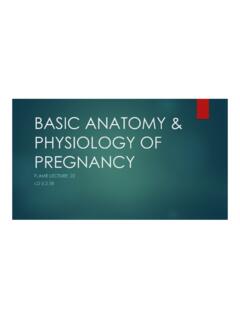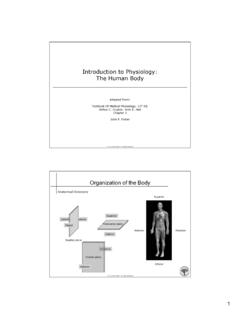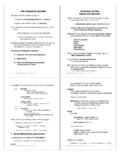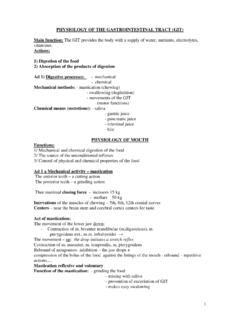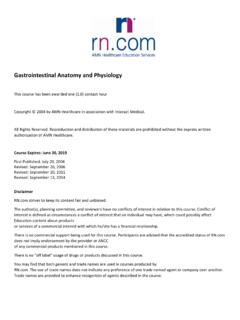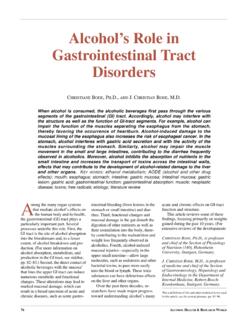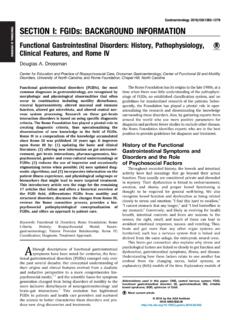Transcription of Introduction to Pharmacodynamics - Jones & Bartlett Learning
1 CHAPTER. Introduction to Pharmacodynamics Reza Karimi 6. 1. Understand the physiology behind the gastrointestinal tract and the route of oral drug administration and Objectives physiological influences on Pharmacodynamics . 2. Understand the dynamics and functions of the major signal transduction systems and their different biomedi- cal and biological responses in regard to receptor ligand interactions. 3. Learn about the dynamics and mathematical expressions behind receptor ligand interactions. 4. Understand dose response relationships and factors that affect a pharmacological response.
2 5. Learn about agonistic, antagonistic, and partial agonistic binding of drugs to receptors. 6. Learn about different concepts such as addition, synergism, and potentiation that lead to an enhancement effect of drugs. 7. List a few regulatory mechanisms for receptors. 8. Implement a series of Learning Bridge assignments at your experiential sites to bridge your didactic Learning with your experiential experiences. 1. cAMP: cyclic adenosine 3' ,5''-monophosphate; a second messenger that plays an important role in signal Key Terms and Definitions transduction. 2. cGMP: cyclic guanosine 3' ,5''monophosphate; a second messenger that plays an important role in signal transduction.
3 3. Dose response relationship: when an endogenous or exogenous ligand binds to a receptor and produces a pharmacological effect. The effect can approach a maximum value (also called Emax) in which a further increase in the ligand concentration does not produce any higher response. 4. Efficacy: the ability of a drug to produce a pharmacological response when it interacts with its receptor. 5. First-pass metabolism: a type of metabolism in which drugs that are absorbed by the gastrointestinal tract go through the portal vein to the liver and are metabolized there before they are distributed to the general circulation.
4 6. Homeostasis: a balanced physiological process that protects and maintains the integrity of the internal envi- ronment ( , an organ, a cell). 7. IP3: inositol 1,4,5-triphosphate; it is generated from the cell membrane's phospholipids, diffuses through the cytoplasm to the endoplasmic reticulum, and binds to its receptor to stimulate Ca2+ channels to open and release Ca2+ into the cytoplasm. 8. Isoforms: two or more protein forms that have the same function but have been expressed by different genes. (continues). 348 1/3/2014 12:49:51 AM. Physiological Influences on Pharmacodynamics 349.
5 9. Isozyme: two or more enzymes that catalyze the same reaction but are expressed by different genes. (continued). 10. MEC: minimum effective concentration; the plasma drug c oncentration that produces the minimum pharmacological effect. 11. MTC: minimum toxic concentration; the plasma drug concentration that produces the minimum toxic effect. 12. PDE: a cyclic nucleotide phosphodiesterase enzyme that degrades either cAMP or cGMP. 13. Pharmacokinetics (PK): the study of the rate and extent of drug absorption, distribution, and elimination from the body. 14. Pharmacodynamics (PD): the study of the molecular interactions of drugs and receptors.
6 15. Pharmacology: the study of how drugs interact with the body to produce a biochemical or physiological effect. 16. Physiological receptors: receptors that can recognize and accept exogenous ligands. 17. Potency: a measure of the concentration (or dose) of a drug that produces 50% of the maximal effect. 18. Protein kinases: a class of enzymes that transfer a phosphate group from an ATP molecule to a protein. 19. Receptors: large intracellular or integral proteins that, by receiving chemical signals, play important roles in many physiological and cellular functions.
7 20. Signal transduction: the movement of signals from outside to inside of a cell, or vice versa. Introduction The field of Pharmacodynamics studies how a ligand (endogenous or exogenous), such as a hormone or a neurotransmitter, binds to its receptor to produce a pharmacological response. In addition, Pharmacodynamics is concerned with factors that affect the ligand receptor binding. Signal transduction is the cornerstone of Pharmacodynamics . This mechanism employs proteins in the form of enzymes or receptors that receive a specific signal and in a sensitive manner convert that signal to a series of biochemical and physiological events.
8 As a result, the specificity and sensitivity of receptors and the concentration of ligands are of paramount importance in Pharmacodynamics . In this chapter, an Introduction to physiology of homeostasis and the gastrointestinal (GI). tract is provided to lay the groundwork for appreciating how different factors affect the role of Pharmacodynamics in oral absorption of drugs. The important roles that efficacy and potency play in producing a dose response relationship are emphasized. In addition, different subtypes of ligand receptor interactions, such as agonistic, antagonistic, and partial agonistic, and a few regulatory mechanisms for receptors are described.
9 Physiological Influences on Pharmacodynamics Receptors are large proteins that play an important role in the field of Pharmacodynamics . Receptors have the ability to amplify physiological signals and, as a result, they are potential targets for drugs. Receptors have two major functions: binding to their specific molecules (ligands) and sending signals (signal transduction) to a series of events. This dual function indicates that there must be at least two domains on a receptor: a ligand-binding domain and an effector domain. The unique characteristic of receptors is that they serve as proteins to recognize and accept e ndogenous and exogenous ligands.
10 Exogenous ligands (xenobiotics or drug products) should, however, mimic the structures of the endogenous ligands. Receptors that can recognize and accept exogenous ligands are called physiological receptors. 349 1/3/2014 12:49:51 AM. 350 Chapter 6 Introduction to Pharmacodynamics Just as a drug's effect is produced after binding to a receptor, so can that effect be terminated when the drug dissociates from the receptor (although an exception exists in the form of constitu- tive activity, a concept that is explained later on in this chapter). If a drug does not dissociate due to a very tight binding (such as a covalent bond), the effect continues to be produced as long as the receptor drug complex remains intact.











